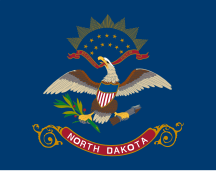Flag of North Dakota
 | |
| Use | Civil and state flag |
|---|---|
| Proportion | 26:33 (3:5 also in use) |
| Adopted | March 11, 1911 (standardized 1943) |
| Design | A shield blazoned "Paleways of 13 pieces, argent and gules; a chief, azure" supported by a bald eagle proper bearing in one talon an olive branch, and seven arrows in the other. In its beak a red scroll bearing the motto E pluribus unum in gold letters. Above are thirteen golden stars in two parallel arches of 7 and 6, surmounted by a gold sunburst. Below is a red scroll inscribed with the state's name in white letters. All on a blue field. |
| Flag of the Governor of North Dakota | |
 | |
The flag of North Dakota represents the U.S. state of North Dakota. Adopted on March 11, 1911, its design is an almost exact replica of the regimental banner carried by the state's troop contingent in the Philippine–American War, the only difference being that the unit designation inscribed on the scroll was replaced by the state's name.
History
[edit]The North Dakota flag's design was officially approved by the North Dakota Legislative Assembly on March 3, 1911, although the color was not specified at the time.[1] Legislation in 1943 brought the flag in line with the original troop banner.
Design and specifications
[edit]The flag's official proportions are 33:26, which is notably shorter than many other state flags. However, in practice, the flag is often produced and sold in 5:3 ratios.[2][3] The state code specifies that the flag must be made from blue silk or another material capable of withstanding the elements.[4]

According to state law, the design of the flag mirrors that of the First North Dakota Infantry's standard during the Spanish–American War and the Philippine–American War.[4] This makes the flag similar to the greater coat of arms of the United States, and nearly identical to many other regimental standards.

A banner with the national coat of arms was carried by all infantry regiments from 1890 to 1904, with the sole distinction being the unit designation inscribed on the scroll underneath the coat of arms.[5] The regimental colors of the North Dakotan troops, for instance, were adorned with the inscription "1st North Dakota Infantry".
It is one of nine U.S. state flags to feature an eagle, alongside those of Illinois, Iowa, Michigan, Missouri, New York, Oregon, Pennsylvania, and Wyoming.
1951 Flag Commission
[edit]In 1951, the North Dakota State Flag Commission was established by S.B. No. 156 (1951 S.L., ch.303) to evaluate the state flag's design. Composed of five members appointed by the Governor, the Commission operated until December 31, 1952, with a mandate to thoroughly assess the flag's origins, dimensions, and its suitability as a symbol for North Dakota.
Regarding the flag's suitability as a symbol of North Dakota, the commission weighed both its historical significance and its alignment with the state's identity. While acknowledging its long-standing presence since 1911 and its association with North Dakota troops in historic conflicts, the commission noted that these factors alone did not inherently make it emblematic of the state. Examining the design's resemblance to the United States coat of arms, the commission emphasized the importance of distinctiveness. Despite minor variations, they deemed the flag too closely resembled the national emblem, suggesting that its symbolism belonged to the entire nation rather than any individual state.
In pursuit of a more fitting motif, the commission explored various avenues including historical figures, state nicknames, and indigenous symbols. However, each option presented challenges or lacked resonance with North Dakota's identity. Certain themes were also deemed either historically inaccurate or too regionally specific. Interestingly, the commission deemed the sources of symbolism that would be used for the state's coat of arms as unsuitable, leaving only the color palette as a point of agreement.

Through a process of elimination, the commission arrived at wheat and sunset as the most suitable symbols for the state flag. Wheat, as the primary crop and symbol of North Dakota's agricultural heritage, represented the state's economic backbone. While the breathtaking sunsets unique to North Dakota captured the state's natural beauty and awe-inspiring landscapes. The commission's recommendation thus crystallized into a proposal: a green flag adorned with golden wheat stems and heads, accompanied by a radiant golden sunset—a tribute to North Dakota's agricultural prowess and celestial splendor. This design aimed to encapsulate the essence of the state's identity while adhering to principles of originality, symbolism, and simplicity, as outlined by the commission's thorough examination of flag design principles and historical context.
The proposed changes were ultimately met with resistance. S.B. No. 265, incorporating the Commission's suggestions, was presented in the 1953 session but failed to pass.[6][7][8][9]
Gallery
[edit]-
Flag of North Dakota at the International Peace Garden, North Dakota-Manitoba Border.
-
The North Dakota state flag as depicted in the 1976 bicentennial postage stamp series.
-
Coat of arms of North Dakota. Adopted 1957.
See also
[edit]References
[edit]- ^ Flag of North Dakota, statesymbolsusa.com.
- ^ "North Dakota State Flag". World Population Review. Archived from the original on July 4, 2023. Retrieved July 3, 2022.
- ^ "The History of the North Dakota State Flag". US Flag Supply. Retrieved July 3, 2022.
- ^ a b "North Dakota State Flag Official Details". State Historical Society of North Dakota. Retrieved July 6, 2022.
- ^ Report of The North Dakota State Flag Commission
- ^ https://ndlegis.gov/assembly/sessionlaws/1951/pdf/statg.pdf [bare URL PDF]
- ^ "Flag Commission - State Agencies - Archives State Historical Society of North Dakota -".
- ^ "North Dakota State Symbols".
- ^ Report of The North Dakota State Flag Commission
External links
[edit]- Information about the flag on the official website of the State of North Dakota




